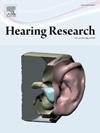Distinct cell classes in the superior paraolivary nucleus (SPN) region in the gerbil auditory brainstem revealed by in vivo physiological and anatomical characterization
IF 2.5
2区 医学
Q1 AUDIOLOGY & SPEECH-LANGUAGE PATHOLOGY
引用次数: 0
Abstract
The superior para-olivary nucleus (SPN or SPON) is a prominent nucleus in the superior olivary complex of the auditory brainstem. The cellular composition of the nucleus reportedly differs between species, but a prominent recurring feature is the unusual characteristic to not respond during a sound but at its offset. Blocking glycine has shown that sound-induced inhibition is the mechanism, but the time course of the responsible synaptic events has not been directly measured in vivo. We obtained intracellular recordings in the Mongolian gerbil (meriones unguiculatus) with patch electrodes containing biocytin, and retrieved 12 labeled neurons with large dendritic trees within and around the SPN region. We found that these neurons could be categorized into three classes that show consistency along multiple dimensions like ultrastructure, spontaneous activity, and responses to current injection and a variety of ipsi- and contralateral sounds. Fast cells fire at onset of depolarizing current, generate short-latency rebound spikes to sound or hyperpolarizing current, and show dense synaptic coverage. Slow cells show sparse synaptic coverage, sustained responses to depolarization, and inhibition with a slow time course to hyperpolarizing current or sound. Uninhibited cells form a third class which profoundly differ in their responses to sound, lacking rebound spiking. We propose that fast cells project to the inferior colliculus, and slow cells to the cochlear nucleus.
求助全文
约1分钟内获得全文
求助全文
来源期刊

Hearing Research
医学-耳鼻喉科学
CiteScore
5.30
自引率
14.30%
发文量
163
审稿时长
75 days
期刊介绍:
The aim of the journal is to provide a forum for papers concerned with basic peripheral and central auditory mechanisms. Emphasis is on experimental and clinical studies, but theoretical and methodological papers will also be considered. The journal publishes original research papers, review and mini- review articles, rapid communications, method/protocol and perspective articles.
Papers submitted should deal with auditory anatomy, physiology, psychophysics, imaging, modeling and behavioural studies in animals and humans, as well as hearing aids and cochlear implants. Papers dealing with the vestibular system are also considered for publication. Papers on comparative aspects of hearing and on effects of drugs and environmental contaminants on hearing function will also be considered. Clinical papers will be accepted when they contribute to the understanding of normal and pathological hearing functions.
 求助内容:
求助内容: 应助结果提醒方式:
应助结果提醒方式:


